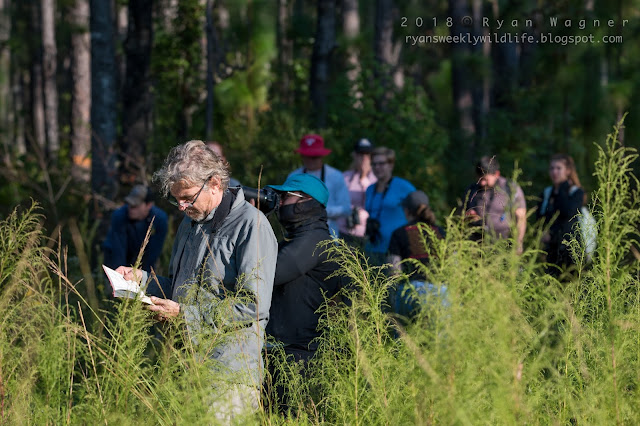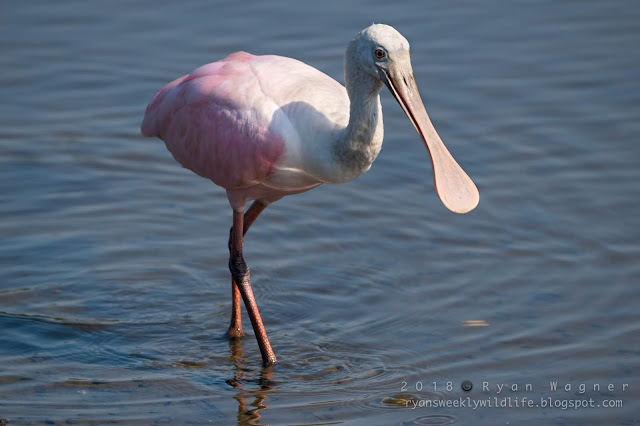Read part one here.
 |
| Tricolored Heron. |
Groves of longleaf pines stood on either side of the single-lane, dirt road as we rattled along, their thin, winding trunks ending in green tufts as if sprouting from the mind of Dr. Seuss. The morning sun was just beginning to peak through the top branches, casting golden rays onto the forest understory. Each time we came upon a tree with a white ring painted around its base we stopped to look and listen, hopeful that an endangered red-cockaded woodpecker (Leuconotopicus borealis) would give itself away.
 |
| Common Yellowthroat. |
“There’s too much understory,” Dr. Miles frequently exclaimed as we moved through the forest. When it comes to habitat preference, the red-cockaded woodpecker is a picky species. It requires old growth stands of longleaf, loblolly, or slash pine with an understory thinned by frequent fires. Unlike other woodpecker species, red-cockadeds utilize only living trees to roost and nest in, as well as to feed on. In our human-transformed world, this once plentiful and dynamic habitat has almost disappeared completely.
 |
| DOMI (Dr. Don Miles) reading his field notes. |
After a trying hour and a half, we had seen brown-headed nuthatches, pine warblers, and even a pileated woodpecker, but our target bird remained illusive. As the day warmed, we decided to head to our next location; perhaps the bird life would be more productive there.
As we drove out, Dr. Miles slowed the van, examining a marked tree in the distance. “Wait here,” he said, “I’ll be right back.” He left the van running as he hopped out of the driver’s seat and disappeared into the undergrowth. As if on queue, a woodpecker zipped up and landed on a tree trunk not 100 feet from where I sat. I scrambled to unlock the van door, grabbing my camera in the process. Focusing my lens on the bird in question, I knew instantly it was our red-cockaded woodpecker. I snapped a series of shots as I motioned for the group to come see. Miles reappeared from the brush and confirmed my identification. As we watched, an entire family group of woodpeckers moved through the trees all around us, filling the air with squeaky, mousy calls like parakeets in a pet shop.
 |
| Red-cockaded Woodpecker. |
The woodpeckers were elegantly patterned with a net of black and white markings across their backs, white, lightly spotted stomachs, black caps and stripes along the lower cheeks. Their common name refers to the “cockade” or reddish streak on the male’s face—a field mark completely invisible at almost any distance. Sadly, red-cockaded woodpecker populations have dwindled significantly since 1966, with declines of 86% across their range. They have disappeared from many states, and populations have become fragmented and isolated. It remains to be seen whether the red-cockaded woodpecker will survive, or if it will join the ranks of its cousin, the extinct Ivory-billed Woodpecker, that once called these same woods home.
 |
| Little Blue Heron. |
With one rare bird to start the day, the rest of the trip was sure to be a success. Tibwin Forest brought us a close encounter with an anhinga and half a dozen young alligators (my personal favorite). After a brief run in with dehydration (I had been so excited to see birds that I forgot to drink water...), we headed for Garris Landing. Foresters terns and boat-tailed grackles drifted over the marshy waterfront. I sat groggily on the pier, sipping my water bottle and admiring the new lifers as they past by.
 |
| Clapper Rail. |
The next day, I was sure to pack extra water as we set off on a quick hour-long drive to Huntington Beach State Park. Huntington is widely considered to be one of the best birding hotspots in South Carolina. We were not disappointed. As soon as we stepped onto the boardwalk, we were surrounded by birds of all shapes and sizes. Snowy and great egrets soared overhead, laughing gulls patrolled the railings, and clapper rails darted between patches of vegetation. In the distance, the trees were spotted with patches of white—dozens of federally threatened wood storks (Mycteria americana).
 |
| Wood Stork. |
A rare species in the US, wood storks are bizarre, snowy white creatures, with gray, bald heads, and an elongate, crooked finger of a bill. What they lack in elegance, they make up for in shear abundance at Huntington Beach. On our drive out, we must have seen 50 or more feeding together along the shore. Huntington is one of the few places in the country that boast wood storks in such large numbers.
 |
| Roseate Spoonbill. |
As we continued walking, I watched as three pink birds touched down at the end of the causeway. Anticipating their quick departure, I decided to jog the length of the road in order to photograph them at close range. I dodged families with strollers and birders with lenses longer than my forearm. As I reached the roseate spoonbills (Platalea ajaja), I quickly realized the birds had no intentions of going anywhere. They fed calmly at the shore, flat bills churning up the mud at their feet. They actually moved closer to me as they dabbled, indifferent to my presence. As the rest of the group caught up, a car passed and someone exclaimed, “look at the flamingos!” Safe to say we all had a good laugh at that.
 |
| Roseate Spoonbill. |
By the mid-afternoon, I was as birded-out as the rest of the group (Dr. Miles wasn't phased). The day was hot and the surf looked incredibly inviting. Other beach goers walked past us, towels slung around their necks, birds the furthest thing from their minds. I was beginning to envy them. After a "two mile hike" (that ended up being four) along the beach, we added the sanderling and ruddy turnstone to our list. Despite my birding fatigue, I was grateful to see the turnstone, a species I have always wanted to find. It hopped along the rocks of an embankment, probing among the barnacles for a tasty invertebrate snack.
 |
| Ruddy Turnstone. |
At long last we were set free for a swim. After three sweaty days without showering, the ocean never felt better. As a wildlife biology and conservation major, I hoped my classes would bring me encounters with exciting birds and herps. I never expected to meet such a great group of fellow fledgling ornithologists. That night, Dr. Miles cooked jambalaya as we relaxed around the campfire and picnic table. The next morning we would head the 10 hours back to Athens, but for now we watched the stars and listened to the barred owls.
 |
| Skylar, Amanda, Remington, and Holly. |
Where my binoculars at?
Keep living the field life!
Ryan
















No comments:
Post a Comment